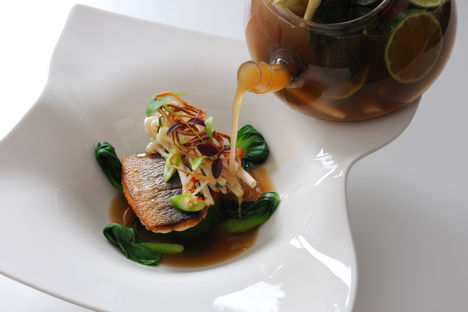Makrut lime leaves (also known as kaffir lime leaves) are an aromatic Asian leaf most often used in Thai, Indonesian and Cambodian recipes. They have a spiced-citrus flavour which is a lot lighter and zestier than a bay leaf or curry leaf. Perfect for lifting a coconut-based broth or fragrant fish curry.
What to look for when buying makrut lime leaves
The leaves have an unusual, hourglass shape, which almost looks like two leaves joined together at the tip. Lime leaves are rich with natural oils, so it's always best to use them fresh if possible. This is tricky for anyone living outside South East Asia though. Luckily, various processing techniques enable makrut lime leaves to be transported round the world, where they are sold in specialist ingredient shops. It's possible to buy preserved, frozen or powdered lime leaves, though they are most widely available in dried, or freeze-dried form.
How to cook with makrut lime leaves
When cooking with makrut leaves, it's best to think of them as a kind of aromatic bay leaf — most commonly used to infuse curries, soups, stir fries or stocks. Cooks 'bruise' or crush fresh leaves in their hands to help release their aromas before adding them to a dish. When using dried leaves, the heat and moisture of cooking helps them release their flavour. Aside from soups and broths, makrut lime leaves can also be used to infuse anything from a pickling juice to a salt cure or sugar syrup.
It's a little more unusual, but some recipes use fresh makrut lime leaves as an ingredient in their own right, either pounding them into a pulp, or slicing them finely — as Nuno Mendes demonstrates in his recipe Thai Explosion II.
What makrut lime leaves go with
Lime leaves make up part of a South East Asian bouquet garni, often paired with ginger and lemongrass. They work well alongside other Thai flavours such as galangal, chillies, ginger and shallots.
The leaves' verdant, citric flavours work beautifully with fish dishes, as demonstrated by Murchison's Bream with galangal broth or Rankin's Thai-style haddock in a bag, as well as shellfish recipes like Ainsworth's Mussel broth, and greens like pak choi or pickled cucumber.
As with lime zest and juice, lime leaves work in a sweet context alongside flavours like coconut, cardamom and papaya. They can also be infused into sugar syrups - perfect for gin cocktails, or with a local spirit like sugar cane Mekhong.
Get in touch
Please sign in or register to send a comment to Great British Chefs.



